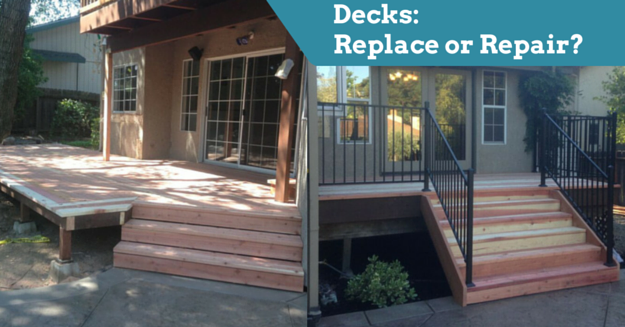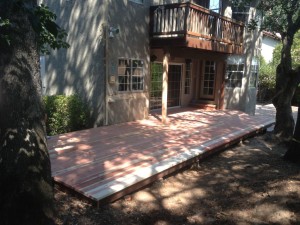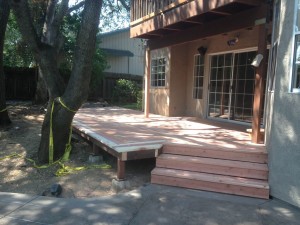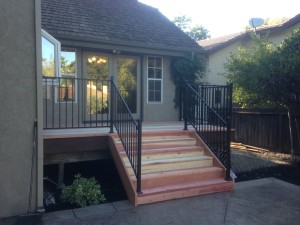
We get many calls from homeowners asking if we can repair their redwood decks. Often the answer isn’t what they want to hear.
If only the deck boards are damaged, we can fix them. But, usually, by the time you notice rotting on top of your deck, it’s too late to save the structure. The primary reason is that visible damage generally means the substructure – the deck’s support – is too far gone to keep. There are occasional exceptions, but safety is always the foremost concern. For example, recently we repaired a deck floor on short notice for a family that wanted it to look good for a graduation party. We made sure it was safe for the occasion, but we must replace the whole structure in the near future.
If you are wondering if your deck can be repaired, contact us for an appointment to inspect it. There are so many variables involved in evaluating a deck that we have to check it out, including crawling underneath, before determining the best course for you.
Whether you build or repair, how long should a deck last? That depends on how it’s built and how well you take care of it.
Your deck’s worst enemy – water
Most deck damage involves dry rot – decayed wood caused by a fungus that thrives in moist conditions. Decks that aren’t built correctly may be more susceptible to damage, but homeowners also need to take care of them.
Here are some things to consider whether you’re buying a house with a deck, building a new one or trying to preserve the one you have:
- First, make sure your deck drains properly. Some of the problems we see have resulted because the deck wasn’t built to shed water correctly. Rain shouldn’t cause moisture problems unless the deck pools water.
- Make sure the wood in your deck is pressure-treated. Pressure-treated wood has been injected with chemicals that resist pests, including the fungus that causes dry rot. We use only pressure-treated wood on our decks.
- Make sure there’s proper airflow underneath. The air will help keep the substructure dry.
- Look for screws instead of nails. Screws are a better fastener for your deck floor, and we always use them for that purpose. They take more time to install, but your deck will last longer.
- Check your plumbing. Sometimes water leaks you don’t see can be making your deck wet, especially in the substructure.
- The worst offender? Your beautiful potted plants. Most homeowners love plants on their decks, and they keep their pots in place for several years. The water that spills or drains goes past the deck boards to the substructure and, inevitably, leads to dry rot. Either move your pots around frequently or use synthetic plants.
And speaking of ‘synthetic’ …
Several synthetic, or manmade, materials that look similar to wood have become popular for deck floors (the supporting structure is always built of wood). There are pros and cons when choosing a deck material – ultimately, it depends on your personal preference. Synthetic decks do last longer but the material is much more expensive — as much as five times more. The labor costs are higher, too. Synthetic decks do require less maintenance, but you don’t get the rustic patina of wood.
Decks can be a beautiful addition to your home, giving you a haven for entertaining or relaxation. We can build them in any style and shape to mold to your environment, even around trees.


